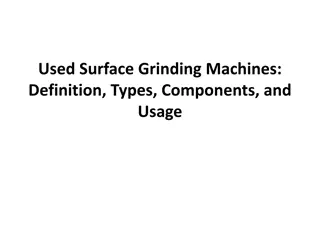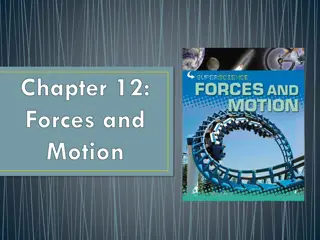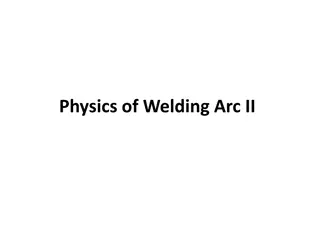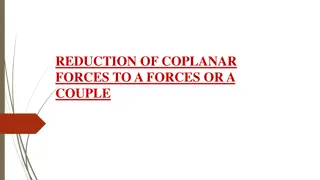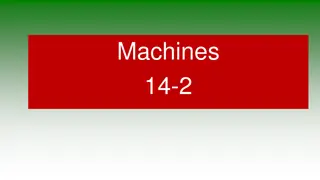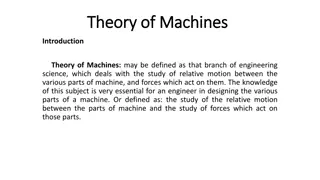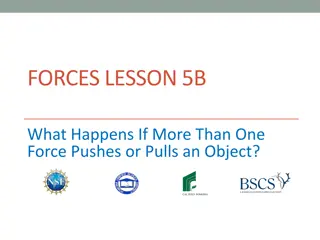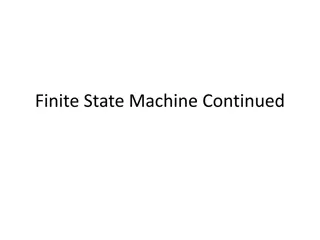Understanding Machines: Work, Forces, and Efficiency
Machines play a vital role in making work easier by increasing force, distance, or changing the direction of applied force. Different types of machines like levers, pulleys, and inclined planes simplify work processes. Understanding input and output forces, as well as input and output work, is essential in considering the efficiency of machines. Ideal machines have no friction, while real machines lose some energy to heat due to frictional forces. Efficiency measures how much input work is converted into useful output work, with high efficiency machines producing less heat from friction. Energy conservation principles govern the relationship between input and output work in machines.
Download Presentation

Please find below an Image/Link to download the presentation.
The content on the website is provided AS IS for your information and personal use only. It may not be sold, licensed, or shared on other websites without obtaining consent from the author. Download presentation by click this link. If you encounter any issues during the download, it is possible that the publisher has removed the file from their server.
E N D
Presentation Transcript
Machines Ch. 5 Sect. 2
Machines A machine is a device that makes doing work easier Three ways that machines make work easier: 1. Increase the force that can be applied to an object i.e. Screwdriver turning a screw, using a crowbar to pry something open 2. Increase the distance over which a force can be applied If work stays the same and distance increases, the required force will be decreased i.e. Pushing an object up a ramp 3. Change the direction of the applied force. i.e. Using a car jack, chopping wood with an axe, opening/closing blinds
Simple Machines A machine that does work with only one movement of the machine Types Lever Pulley Wedge Inclined Plane Screw Wheel & Axle With a simple machine you can never increase both the force and the distance! If you gain one, you sacrifice (lose) the other. http://ed101.bu.edu/StudentDoc/Archives/ED101sp10/rawdons/images/moving-pulley.jpg
Machines There are two forces involved when a machine is used for work: 1. Input force (Finput) the force that is applied to the machine 2. Output force (Foutput) the force that is applied by the machine
Machines There are two kinds of work that need to be considered 1. Input work (Winput)- The work done by you on the machine 2. Output work (Woutput)- The work done by the machine Remember that energy is conserved. When you do work you transfer energy to the machine. When the machine does work on an object, energy is transferred to the object. Because energy cannot be created or destroyed, the amount of energy transferred to the object cannot be greater than the amount of energy you transferred to the machine. Woutput is never greater than Winput.
Ideal vs. Real Machines Ideal Machine A perfect machine in which there was no friction. No work would be lost to heat. For an ideal machine, Winput = Woutput. Real Machine For real machines, some of the energy put into a machine is always converted into heat by frictional forces. Therefore, Woutput < Winput.
Efficiency Efficiency is a measure of how much of the work put into a machine is changed into useful output work by the machine. A high efficiency machine produces lessheat from friction so more of the input work is changed to useful output work. Efficiency can be calculated by: ???? ?????? ???? ????? ? 100 ??????? ?????????? =
Efficiency In an ideal machine there is no friction and the output work equals the input work. So the efficiency of an ideal machine is 100%. In a real machine, friction causes the output work to always be less than the input work. So the efficiency of a real machine is always less than 100%.
http://image.atvrideronline.com/f/19595343+w750+st0/0907_atvp_02_z+wd_40+.jpghttp://image.atvrideronline.com/f/19595343+w750+st0/0907_atvp_02_z+wd_40+.jpg Efficiency Machines can be made more efficient by reducing friction. This is usually done by adding a lubricant, such as oil or grease, to surfaces that rub together. A lubricant fills in the gaps between the surfaces, enabling the surfaces to slide past each other more easily. http://upload.wikimedia.org/wikipedia/commons/thumb/1/19/Joint.png/400px-Joint.png http://assets.farmandfleet.com/p600/230640-20121005003158-victor-powdered-graphite-lubricant.jpg
Calculating Efficiency An inclined plane allows you to do 280 J of useful work on a refrigerator that you are sliding upward along the plane. If the work that you have to do is 760 J, what is the efficiency of the inclined plane? Win = 760 J Wout = 280 J ??????? ?????????? = ???? ?????? ???? ????? ? 100 ??????? ?????????? = 280 ? 760 ? ? 100 = 37% A lever requires you to push with 75N of force to move it 1 meter. The 125 N rock on the other end moved 0.3 m. What is the efficiency of this lever? ???? ?????? ???? ????? ? 100 ??????? ?????????? = Win = 75 N x 1 m = 75 J Wout = 125 N x 0.3 m = 37.5 J 37.5 ? 75 ? ? 100 = 50% ??????? ?????????? =



